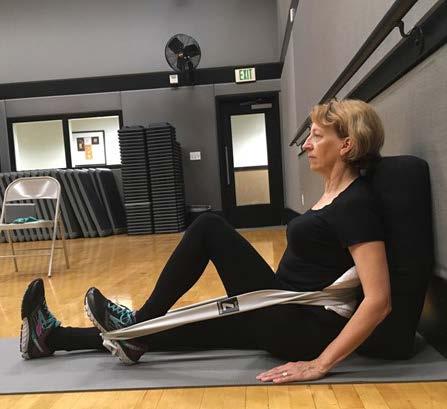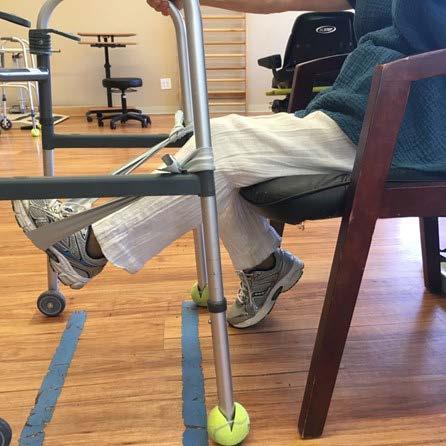
8 minute read
Mitigating Frailty: Opportunities Ahead

Modified leg press using resistive bands
Advertisement
by Linda McAllister PT, DPT and Carole Lewis PT, PhD, FAPTA
As the proportion of the older adult population rises in the Unted States, the number of older adults with frailty is also increasing. Frailty has been defined in varying ways, but a well- accepted definition marks frailty by unintentional weight loss, low strength, reduced physical activity, the feeling of exhaustion, and slow walking speed.1 Frailty can have a slow, insidious onset, with sarcopenia often silently present and putting one at increased risk for developing frailty. A critical feature of frailty is that it is a state of vulnerability. Frailty can lead to a downward spiral. Older adults with this syndrome have increased risk for falls, disability, hospitalizations, and mortality. 2,3
Varied approaches toward addressing frailty have been studied. One component emerges from systematic reviews that shows more promise for improvement: physical activity intervention.4 Muscle weakness is a key marker of frailty; targeting this weakness is essential. Resistive training protocols stand out as being “consistently effective” in the treatment of frailty.5 Muscle strength training with protein supplementation have also shown consistently greater effectiveness.6 Physical therapists can play a key role by applying well-dosed, robust strengthening interventions. Falvey et al have proposed that high-intensity resistive training should be the cornerstone of interventions for hospital associated deconditioning (which can rapidly uncover frailty) instead of a traditional lower intensity approach.7
Decades of research has shown that older adults, even sedentary and those with multi-morbidity, can participate in higher intensity strength training and demonstrate meaningful improvements.8 Benefits include reduced falls and fear of falling and improved physical performance. High-intensity resistive training is also shown to be one of the most effective exercise modalities to improve preferred gait speed.9 High-intensity motor control interventions of gait and balance can also mitigate frailty: participants have demonstrated an improvement in their frailty classification, e.g., moved from “frail” to “pre- frail.”10
Many referrals to PT are reactive, initiated because of an illness or injury. Frailty puts older adults at higher risk for these negative events. Physical therapists are uniquely poised to identify and address this vulnerability. Although our typically reactionary medical system pushes us to focus on the new injury or illness, physical therapists can look deeper to see underlying frailty or susceptibility to frailty. Here is a great opportunity for prevention! Therapists can address the weakness that made one vulnerable to an adverse event in the first place. Although getting “back to baseline” is a common therapy paradigm, one’s baseline can potentially be improved with the right exercise interventions, increasing functional reserve and resilience to help prevent future adverse events.7 Often,

Modified leg press with bands stabilized on a walker.

the prior level of function was insufficient to prevent them from getting into trouble.
Many therapists are working with reduced visit numbers and restricted time with older adults in the wake of changed payment models. The Covid-19 pandemic has been another barrier to access older adults susceptible to frailty. In the precious therapy time we have with older adults, what might it look like in various settings to capitalize on the most effective interventions to mitigate frailty? Here are some suggestions to consider when using strengthening interventions for older adults with frailty:
1. Target important muscle groups for function.
Some examples from the literature are: knee extensors, hip extensors, hip abductors, plantar flexors and triceps12 • The leg press is used in many research protocols and uses a combination of the important muscle groups listed above. • Sit - stand, squats, lunges or similar closed chain functional exercises are also included in many studies and target the muscles listed above and can be strengthened appropriately, with the addition of weights or bands as needed for sufficient intensity.
2. Choose an appropriate resistance level: 80% of one-repetition maximum is ideal for strengthening. • While the older adult may need a lighter resistance level especially at first due to comorbidities, this does not exclude them from resistance training. Start with a lower level and intentionally work towards a higher level. 3. Know how to dose the appropriate resistance level, using one of the following methods: • Use perceived rating of exertion (e.g., “hard” to
“very hard” for 80% of one repetition maximum). • Count the number of repetitions that the patient can perform and look for signs of fatigue and failure. For a high intensity exercise, make the exercise hard enough that there is failure at 8-10 repetitions – e.g., they physically are unable to perform an additional repetition past the set. • Use a formula (there are many in the literature) or a 1-repetition maximum app to determine what one repetition maximum is for an exercise.
Use this one repetition maximum value as a basis to calculate the amount of resistance needed.
Acute care. Consider initiating strengthening interventions at a lower intensity. Recent work by Martinez-Velilla et al in an acute setting demonstrated that a 5-7 day, 20 minute intervention including progressive resistive training at 30-60% of 1 repetition maximum, with balance and gait training, significantly improved function and cognition.11
Skilled nursing facilities/post-acute inpatient set-
tings. Therapists can incorporate well-dosed resistive training, alternating muscle groups on different days. Re-
sistive training can be included for all key muscle groups, not just those directly affected by the illness or injury. Therapists can use specific principles to progressively upgrade the activity. In addition to teaching safe mobility strategies, therapists can use high-level motor control gait and balance activities.
Home health. Therapists can continue robust strengthening interventions and determine what high- intensity exercises the patient can safely perform at home on their own or with assist. While home safety is critical and should be addressed, the correct level of intensity for exercise is also crucial to mitigating frailty.
Outpatient settings. Older adults who access therapy in this setting for any reason can be screened for sarcopenia and risk for physical decline and frailty. Therapists can educate on the risks of weakness and teach preventative strengthening programs.
Much research demonstrates the effectiveness of the leg press, unfortunately this piece of equipment is lacking in many clinics. Using resistive bands to mimic a leg press has been demonstrated in the literature.13 Bands can be stabilized on a gait belt, or walker, which is stabilized by a therapist or assistant (see photos). Portable leg presses are also available for a lower cost than gym equipment and can be transported to different rooms and locations.
Every encounter with an older adult, in any point on the continuum of care, offers an opportunity to educate on the critical need to maintain or improve muscle strength. It provides an occasion to initiate higher intensity interventions that can reverse a downward spiral. Physical therapists can use their unique position and expertise as strength experts to work toward preventing or reversing frailty whenever possible.
References
1. Fried LP, Tangen CM, Walston J, et al. Frailty in Older Adults: Evidence for a Phenotype. J Gerontol A Biol Sci Med Sci. 2001; 56(3):
M146-56. 2. Hewitt J, Carter B, Vilches-Moraga A, et al. The effect of frailty on survival in patients with COVID-19 (COPE): a multicentre, European, observational cohort study. Lancet Public Health. 2020 Jun 30;
S2468-2667. doi: 10.1016/S2468-2667 20)30146-8. 3. Hao Q, Zhou L, Dong B, et al. The role of frailty in predicting mortality and readmission in older adults in acute wards: a prospective study.
Sci Rep. 2019; 9:1207. 4. Kidd T, Mold F, Jones C, et al. What are the most effective interventions to improve physical performance in pre-frail and frail adults?
A systematic review of randomized control trials. BMC Geriatrics. 2019; 19:184. 5. Kojima G, Liljas AEM, Iliffe S. Frailty syndrome: implications and challenges for health care policy. Risk Management Health
Policy.2019; 12: 23-30. 6. Travers, J, Romero-Ortuno R, Bailey J, Cooney, MT. Delaying and reversing frailty: a systematic review of primary care interventions.
Br J Gen Prac. 2019 Jan; 69(678): e61-e69. 7. Falvey JR, Mangione KK, Stevens-Lapsley JE. Rethinking hospitalassociated deconditioning: proposed paradigm shift. Phys Ther. 2015; 95(9): 1307-1315. 8. Fiatarone MA, Marks EC, Ryan ND, et al High-intensity strength training in nonagenarians: effects on skeletal muscle. JAMA. 1990;263:3029-34. 9. de Labra C, Guimaraes-Pinheiro C, Maseda A, et al. Effects of physical exercise interventions in frail older adults: a systematic review of randomized controlled trials. BMC Geriatrics. 2015; 15:154. 10. Danilovich MK, Conroy DE, Hornby TG. Feasibility and Impact of
High-Intensity Walking Training in Frail Older Adults. J Aging Phys
Act. 2017; 25:533-538. 11. Martinez-Velilla N, Casas-Herrero A, Zambom-Ferraresi F, et al.
JAMA Intern Med. 2019; 179(1):28-36. 12. Singh NA, Quine S, Clemson LM et al. Effects of High-Intensity
Progressive Resistance Training and Targeted Multidisciplinary
Treatment of Frailty on Mortality and Nursing Home Admissions after Hip Fracture: A Randomized Controlled Trial. J Am Med Dir
Assoc. 2012 Jan; 13(1):24-30. 13. Chang TF, Lioiu TH, Chen CH, et al. Effects of elastic-band on lowerextremity function among female patients with osteoarthritis of the knee. Disabil Rehabil. 2012; 34(20):1727-1735.
Carole Lewis, PT, DPT, GCS, GTCCS, MPA, MSG, PhD, FSOAE, FAPTA, is the president of and faculty for GREAT Seminars and Books and Great Seminars Online (www.greatseminarsandbooks.com and www.greatseminarsonline.com). She has her own private practice in Washington DC. She is editor-in-chief of Topics in Geriatric Rehabilitation and an adjunct professor in George Washington University’s College of Medicine.
Linda McAllister, PT, DPT, GCS, GTCCS, CEAGN is a board-certified Geriatric Specialist and lecturer with Great Seminars and Books. She currently practices in home health with EvergreenHealth in Kirkland, WA. She is an adjunct faculty member of Arcadia University and serves as coordinator for the Geriatric Training Certification with the Geriatric Rehabilitation Education Institute.
APTA Geriatrics continues to collect resources related to geriatrics, physical therapy, and the response to COVID-19. Resources include webinars, documents and links to related organizations.
geriatricspt.org/practice/covid-19









